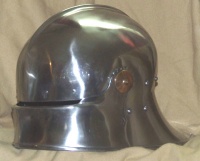Sallet: Difference between revisions
From Cunnan
Jump to navigationJump to search
No edit summary |
No edit summary |
||
| (4 intermediate revisions by the same user not shown) | |||
| Line 1: | Line 1: | ||
[[image:sallet01.jpg|right|200px|thumb|Replica 15th century sallet.]] |
[[image:sallet01.jpg|right|200px|thumb|Replica 15th century sallet.]] |
||
A '''sallet''' |
A '''sallet''' (also ''salade'' or ''celata'') is a [[plate]] [[helmet]] with a pointed tail and either an open face or a horizontal eye slot. Common pronunciations are either ''sal ay'' ([[France|French]]) or ''sal et'' (contemporary [[England|English]] pronounciation)). It is frequently, but not always, worn with a [[bevor]]. |
||
The jawbone may be articulated to allow greater airflow, and sometimes the tail might be articulated. The helmet may have also been painted with [[religion| |
The jawbone may be articulated to allow greater airflow, and sometimes the tail might be articulated. The helmet may have also been painted with [[religion|religous]] [[slogan]]s being popular as well as [[livery]] style colours. |
||
This was a popular helmet type during the [[15th century]] particularly in the latter part. It was worn by [[noble]]s and [[man at arms|men at arms]]. |
This was a popular helmet type during the [[15th century]] particularly in the latter part. It was worn by [[noble]]s and [[man at arms|men at arms]]. |
||
[[category:armour]] [[category:full harness]][[category:15th century]][[Category:artefact (medieval)]] [[category:helmets]] |
|||
[[category:armour]] |
|||
Latest revision as of 19:15, 16 March 2007
A sallet (also salade or celata) is a plate helmet with a pointed tail and either an open face or a horizontal eye slot. Common pronunciations are either sal ay (French) or sal et (contemporary English pronounciation)). It is frequently, but not always, worn with a bevor.
The jawbone may be articulated to allow greater airflow, and sometimes the tail might be articulated. The helmet may have also been painted with religous slogans being popular as well as livery style colours.
This was a popular helmet type during the 15th century particularly in the latter part. It was worn by nobles and men at arms.
